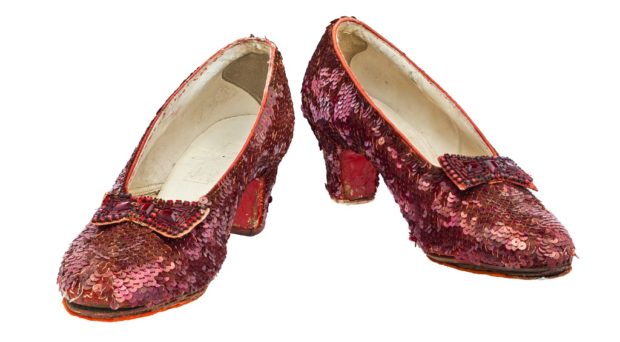
The blog post has been cross-posted from the SpringerOpen blog.
Smithsonian research scientists at the Museum Conservation Institute (MCI) have collaborated with conservators at the National Museum of American History (NMAH) on an in-depth materials characterization study of the iconic Dorothy’s Ruby Slippers from the 1939 classic film, The Wizard of Oz, which have been in collections of the NMAH since 1979. Renewed interest in the Ruby Slippers began in the early stages of preparation for a new exhibition at NMAH to open in October 2018. The results of this study are reported in a new article published in Heritage Science. Visible deterioration of the decades-old shoes and concerns for their utmost care led to a rare opportunity to learn about their original construction and subsequent history. Non- and minimally invasive analytical methods were used to characterize the shoes’ components, such as sequins, beads and rhinestones, prong settings, paint, adhesives, textile fibers, and heel materials. Methods used include micro-X-ray fluorescence spectroscopy (µ-XRF), micro–Fourier transform infrared spectroscopy (µ-FTIR), polarized light microscopy (PLM), and high-performance liquid chromatography – diode array detector – mass spectrometry (HPLC–DAD–MS).
Creating an icon
The Ruby Slippers were created by adorning commercially available pump-style shoes that had been dyed red. A red sequined netting was sewn to each shoe, and handcrafted bows with beads and rhinestones were sewn near the toe. As several pairs of Ruby Slippers are known to have been made for the movie, and through the study it became apparent the slippers are not a matched pair; instead, each slipper is from a different pair.
As several pairs of Ruby Slippers are known to have been made for the movie, and through the study it became apparent the slippers are not a matched pair; instead each slipper is from a different pair.
The red sequins are composed of a protein-based core (most likely gelatin) laminated on both sides with a thin layer of cellulose nitrate. The findings are in agreement with known compositions of gelatin-based sequins of similar age reported in the literature. The main red colorant of the cellulose nitrate was identified as Rhodamine B by HPLC-DAD-MS.
Historically, some manufacturers used thin metallic coatings laminated on to other structural layers of sequins, presumably to enhance reflective effects. Study of a detached sequin shows that this is the case here (see fig): on one side, the sequin has a thin and fragile silver layer. The degraded silver layer has presented a treatment challenge because it has dulled the appearance of the slippers.

Past, present, and future
Some damage to the Ruby Slippers was identified, for example, lost red rhinestones were replaced with colorless leaded-glass ones that were colored using a red cellulose nitrate-based material to match the originals. This colorant may have been applied as nail polish or hobby paint. The findings suggest that both of the Smithsonian’s Ruby Slippers were actively used during filming, and likely repaired and modified at that time.
The findings suggest that both of the Smithsonian’s Ruby Slippers were actively used during filming, and likely repaired and modified at that time.
On the basis of this research, informed decisions were made on the environmental conditions for the new permanent exhibition of the Ruby Slippers at NMAH. We also have enhanced our understanding of how these extraordinary slippers were made and used. The results are particularly timely in light of the FBI’s recent recovery of another pair of Ruby Slippers that went missing for 13 years. Materials and construction of the recovered pair have recently been compared to the Smithsonian’s pair. Results show that the recovered shoes and the pair in the Smithsonian’s museum collection are mismatched twins. The modern tools of science have proven to be crucial as the history of Dorothy’s Ruby Slippers continues to unfold.
Comments